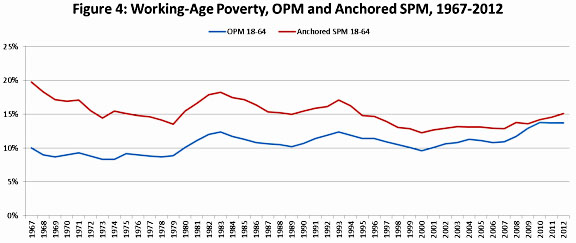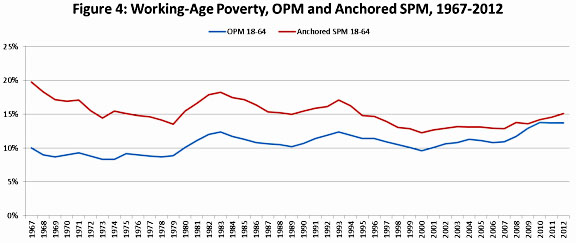
The Washington Post reports some good news:
Government programs such as food stamps and unemployment insurance have made significant progress in easing the plight of the poor in the half-century since the launch of the war on poverty, according to a major new study….[The findings] also contradict the official poverty rate, which suggests there has been no decline in the percentage of Americans experiencing poverty since then.
According to the new research, the safety net helped reduce the percentage of Americans in poverty from 26 percent in 1967 to 16 percent in 2012.
There are certain things you always need to be aware of in different fields of study. If it’s test scores among school kids, you need to disaggregate by race and ethnic background. If it’s life expectancy and Social Security, you need to make sure to use life expectancy at age 65, not life expectancy at birth. And if it’s poverty measurements, you need to distinguish between elderly poverty and working-age poverty.
Social Security has dramatically reduced elderly poverty, so if you simply look at overall poverty rates they’re always pulled down by the success of Social Security. But what about the working-age poor? How have government programs helped them? This was the first thing I looked for in this new study, and I found it in the red line in Figure 4:

This is a lot less cheery. Poverty has still declined, but not by much, and only between 1967 and 1973. Since 1973, the poverty rate hasn’t budged. It was 15 percent forty years ago and it’s 15 percent today.
Now, there’s still some good news in this study. Using their new measurement, the researchers find that child poverty has dropped from from 31 percent to 18 percent over the past three decades. They also find that safety net programs have reduced poverty rates and dramatically reduced “deep poverty” rates. It’s also heartening that poverty rates increased only slightly during the Great Recession. Safety net programs have significantly ameliorated a human catastrophe over the past five years.
But the headline result, I think, is simple: among the working-age poor, poverty has been stuck for the past four decades. We’ve made virtually no progress at all.















